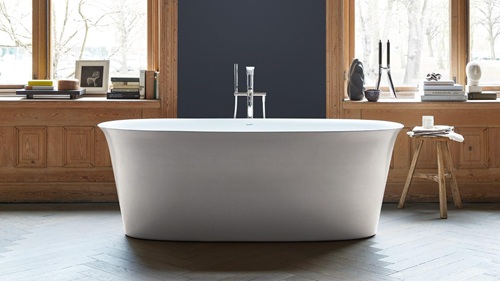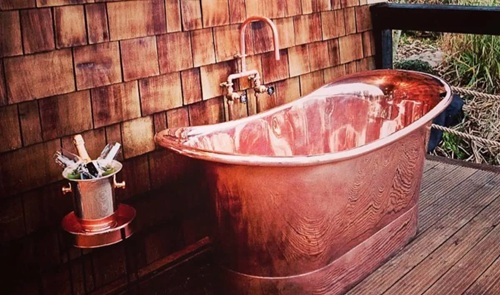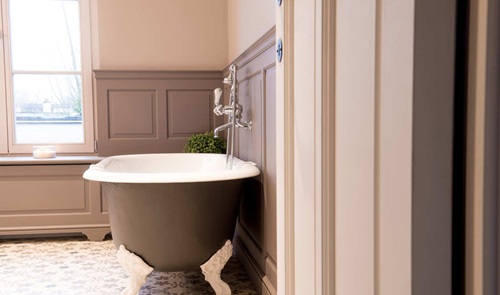When it comes to remodeling or designing a bathroom, choosing the right bathtub is a key decision. Among the many types available today, acrylic bathtubs have emerged as one of the most popular choices for modern homes. Loved for their affordability, versatility, and sleek finish, acrylic tubs offer many advantages—yet they’re not without some drawbacks.
Lets break down the pros and cons of acrylic bathtubs. Whether you’re a homeowner on a budget or a designer seeking flexibility in form and finish, this detailed guide will help you decide if acrylic is the right material for your bathroom.

🛁 What Is an Acrylic Bathtub?
An acrylic bathtub is made from a solid sheet of vacuum-formed acrylic that is reinforced with fiberglass for added strength and durability. This combination creates a lightweight yet resilient material that’s warm to the touch and easy to shape into different sizes and styles.
Acrylic tubs are available in various designs—freestanding, alcove, drop-in, corner, and soaking tubs—making them suitable for bathrooms of all shapes and sizes.
✅ Pros of Acrylic Bathtubs
1. Affordable and Cost-Effective
One of the biggest advantages of acrylic bathtubs is their affordability. Compared to cast iron, stone resin, or solid surface tubs, acrylic offers a budget-friendly alternative without sacrificing appearance or comfort.
Price Range (India): ₹10,000 to ₹50,000+
Price Range (USA): $300 to $1,500+
2. Lightweight and Easy to Install
Acrylic tubs weigh significantly less than cast iron or steel tubs, making them ideal for multi-story homes or bathroom renovations where structural reinforcement might be a concern.
Fun Fact: A typical acrylic tub weighs around 70–100 pounds, while a cast iron tub may exceed 300 pounds.
3. Warm to the Touch
Acrylic is naturally insulating, meaning it feels warm even before the water is added. This offers an inviting bathing experience, unlike materials like porcelain or steel which feel cold initially.
4. Non-Porous and Stain Resistant
The smooth, non-porous surface of acrylic resists stains, mildew, and grime. This makes it easy to clean with just mild soap and a soft cloth—no need for harsh chemicals or abrasive scrubbers.
5. Variety of Shapes, Sizes, and Colors
Because acrylic is easily moldable, manufacturers can create a wide array of customizable designs. Whether you prefer minimalist lines or deep, sculpted curves, there’s likely an acrylic tub that suits your style and bathroom layout.
Design Tip: Acrylic tubs are available in both glossy and matte finishes, as well as custom colors for modern interior themes.
6. Repairable Surface
Acrylic tubs are relatively soft, which means that minor scratches or scuffs can often be buffed out or repaired with a DIY acrylic repair kit. This extends the life of the tub and keeps it looking new.
7. Comfortable and Ergonomic
Due to its flexible construction, acrylic tubs often have smoother, more comfortable contours. This is especially ideal for soaking tubs or ergonomic designs that conform to the body.
❌ Cons of Acrylic Bathtubs
1. Prone to Scratching
Although acrylic resists stains, the surface can scratch easily if cleaned with abrasive tools or exposed to sharp objects like razors, metal buckets, or heavy cookware.
Tip: Avoid using steel wool, hard-bristle brushes, or harsh chemicals like bleach when cleaning your acrylic tub.
2. Less Durable Than Cast Iron or Stone
While acrylic is tough for its weight, it’s not as durable as cast iron, steel, or stone resin. It may flex slightly under weight, and over time, fiberglass reinforcement can weaken if not properly maintained.
3. Sensitive to Heat and Chemicals
Extremely hot water (above 60°C or 140°F) or exposure to certain chemicals can warp or discolor the acrylic surface. Bath oils and dye-based products may also stain the material over time.
Pro Tip: Always check the manufacturer’s care instructions before using bath additives or essential oils.
4. May Fade Over Time
With prolonged exposure to UV rays or harsh lighting, some lower-quality acrylic tubs may fade or yellow. This is more common in low-end products that lack adequate UV protection.
5. Feels Less “Premium” Than Heavier Materials
While acrylic tubs look attractive, they may lack the luxurious, solid feel of heavier materials like cast iron or stone. This may not matter to most users, but it’s something to consider if you’re aiming for a luxury aesthetic.
⚖️ Acrylic Bathtubs vs Other Bathtub Materials
| Feature | Acrylic | Cast Iron | Fiberglass | Stone Resin |
| Cost | Low to Moderate | High | Low | High |
| Weight | Light | Very Heavy | Very Light | Heavy |
| Heat Retention | Good | Excellent | Poor | Very Good |
| Durability | Moderate | Excellent | Low | Excellent |
| Scratch Resistance | Fair | High | Low | High |
| Design Flexibility | Excellent | Limited | Good | Moderate |
| Maintenance | Easy | Moderate | High | Moderate |
🛠️ Maintenance Tips for Acrylic Bathtubs
- Clean Weekly: Use a mild soap and soft sponge to prevent buildup of soap scum or body oils.
- Avoid Abrasives: Never use scouring pads, steel wool, or harsh chemicals like acetone or bleach.
- Rinse After Use: Especially after using bath products, to prevent staining.
- Polish Scratches: Minor marks can be buffed with a soft cloth and acrylic polish.
- Install Proper Support: Make sure the tub is installed with even floor support to prevent flexing or cracking over time.
🏁 Is an Acrylic Bathtub Right for You?
✅ Choose an Acrylic Bathtub If:
- You’re looking for a budget-friendly, stylish tub.
- You need a lightweight option for an upper-floor bathroom.
- You want easy installation and low maintenance.
- You value design flexibility in terms of shape, size, and color.
❌ Avoid an Acrylic Bathtub If:
- You prefer luxury, high-end aesthetics with a solid feel.
- Your household includes children or heavy usage, increasing scratch risk.
- You want a tub that lasts decades with minimal wear.
- You regularly use bath salts, dyes, or strong cleaners that could damage the finish.
🧼 Final Verdict
Acrylic bathtubs offer a versatile, comfortable, and cost-effective solution for modern homes. With their sleek appearance, warmth, and ease of installation, they’re ideal for homeowners seeking a practical and attractive tub without the hefty price tag.
While they may not match the durability of cast iron or the luxe feel of stone, acrylic tubs more than make up for it with accessibility, customizability, and comfort. If you’re renovating on a budget or need a stylish upgrade that’s easy to live with, acrylic is a smart and sensible choice.

